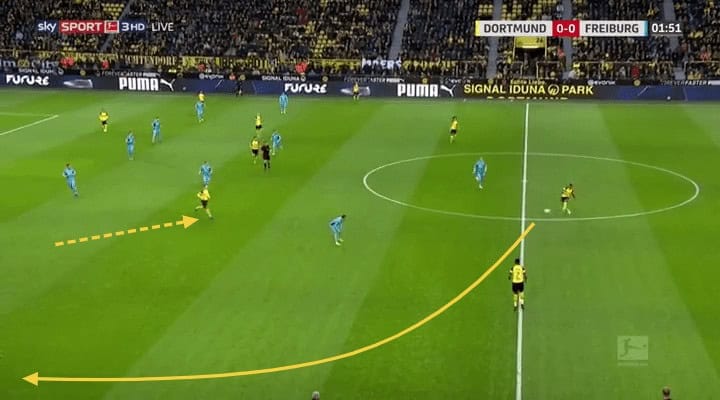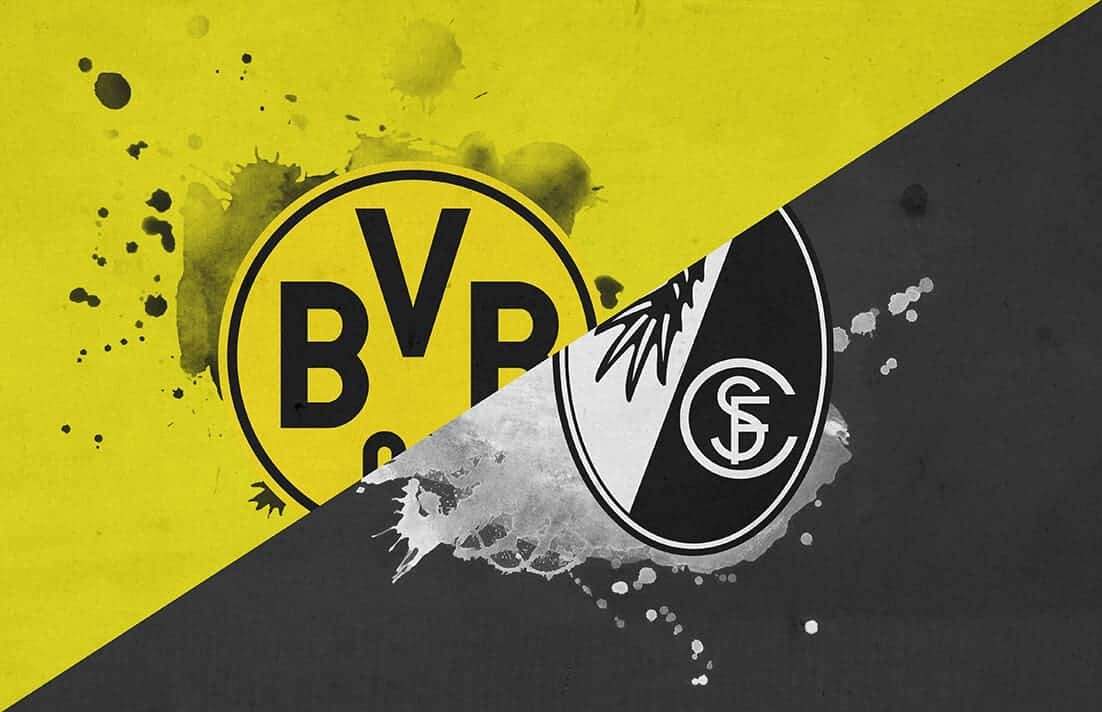Borussia Dortmund beat Freiburg 2-0 at home to go yet another game unbeaten in the Bundesliga this season. The win came after securing progression to the UEFA Champions League knockout round last week, and now Lucien Favre’s side sits 7 points clear at the top of the table.
The game was relatively entertaining and Dortmund coped with the challenges presented by Freiburg relatively well. The visitors, however, weren’t the most dangerous opponent and they lacked the range of attacking options to trouble Dortmund a bit further. Dortmund were very comfortable and maintained possession for long periods without doing too much to threaten either.
Let’s take a deeper look at how the battle that played out:
Lineups:
Borussia Dortmund (4-2-3-1): Burki; Piszczek, Diallo, Zagadou, Hakimi; Witsel, Delaney; Sancho, Reus, Larsen; Gotze
Freiburg (5-4-1): Schwolow; Stenzel, Gulde, Koch, Heintz, Gunter; Waldschmidt, Haberer, Gondorf, Frantz; Petersen
Dortmund Maintain Possession Against Freiburg’s Mixed Pressing
Freiburg began the game using a 5-4-1 formation. Christian Streich, Freiburg’s coach would’ve watched Dortmund’s previous game against Brugge, and he would’ve known how important it was for his side to defend as compactly as possible. Haberer and Gondorf worked together in central midfield and they tried their best to control this area defensively as Dortmund dominated possession. However, Freiburg’s wide midfielders and forward Nils Petersen struggled to work defensively in unison and thus allowed Dortmund to maintain possession under pressure and after losing the ball while facing a deep-defensive block.
From kick-off, they pressed Dortmund in attacking areas trying to win the ball before counter-attacking directly. Their 5-4-1 shape would change into a 5-2-3 with both Waldschmidt and Frantz pushing forward to press the opposing full-back. One of the midfielders would press, Petersen would press the ball-near centre-back and the ball-far wide midfielder would tuck in to provide cover along with the two central midfielders. Freiburg made the use of their wingbacks by tasking them with marking any open players in behind one of their wide midfielders. Freiburg had 2 wide centre-backs to cover the flanks in case Dortmund managed to advance beyond their midfield line.
Dortmund, who play a possession-based style, were well equipped to dealing with the pressure and zonal/man-to-man marking they faced. What made it even easier for Dortmund to keep the ball was the fact that Freiburg were often at a numerical disadvantage whilst pressing. Mario Gotze played as the lone striker against 3 defenders, so this meant that Dortmund always had an extra player in defence and midfield. One channel that Dortmund value above all because of it’s attacking potential is the half-space. Freiburg were unable to close down this channel when pressing high was because they only played with two central midfielders and two wingbacks. Dortmund always managed to find space and use it to retain and circulate possession.
Freiburg’s forward line lacked the required cover to make a high press successful. Firstly, Delaney and Witsel playing as the double pivot, forced their forward line to make a sacrifice when applying pressure. They would either have to press the backline and leave the two midfielders open or wait for an opportunity to press by marking them. This would then allow Diallo or Zagadou more time and space to distribute the ball. The lack of defensive cover during high-pressing situations caused Freiburg to defend from deep and wait for access, to press, rather than actively seeking to win the ball back, as the game went on.


Reus, Bruun Larsen and Sancho stayed mobile constantly to support players under pressure. Larsen, for example, did brilliantly to support Dortmund’s progressions out from the back with his movement. When the defenders and midfielders were marked, he always managed to provide a passing option or open up channels/passing lanes by dropping into the half-space in midfield from his advanced wide position.

The home side however still faced one big issue: breaking down the last two lines of Freiburg’s defence.
Sterile Possession:
Dortmund, despite almost notching up 70% possession, only created 7 key passes the whole game one of which resulted in a goal in added time. Before I explore why this happened, it’s important to note that from a defensive standpoint, at least they were in control from start to finish. Their occupation of the midfield area, also made it extremely hard for Freiburg to construct attacks or execute efficient counter-attacking moves. Dortmund often played with a high line but this was hardly risky as their counter-cover was solid (thanks to the defensive movements of their players in possession and their double pivot) and Freiburg were always under-loaded when going forward. Plus the fact that they defended so deep made even harder to execute counter-attacks because of the distance to Dortmund’s goal.
From an attacking standpoint though, Dortmund’s possession was mostly futile. In the first half an hour, when Freiburg still had the energy to press high (which was also futile to a certain extent), they found more space in advanced zones to attack at speed after escaping the press. Throughout this period they created 5 key passes and won a penalty (after Sancho was fouled at the end of a quick break). After this period, however, with Freiburg opting to focus on controlling their own defensive zones rather than winning the ball, Dortmund found less space in advanced zones. Disappointingly, and yet again, Dortmund struggled to break down a dense defence. Their inability to create space positionally means that opposition teams find it easy to channel Dortmund’s attacks into non-threatening areas. There were very few of positional rotations and connections between players in and outside of Freiburg’s defensive block. The result? 67% possession and only one goal scored in open play…in the 91st minute.
Conclusion:
Credit should be given to Dortmund for remaining unbeaten and winning a full 3 points. Defensively they were hardly troubled but their attacking play, especially at this stage of the season is a huge concern. Their inability to break down teams positionally creates a dangerous precedent for the defining part of the season, which comes after the winter break. Thomas Tuchel managed to rectify this exact issue when he replaced Jurgen Klopp when he introduced a pro-active, positional attacking style. His departure saw Dortmund return to the lacklustre possession-based style (heavily reliant on chance and opponents mistakes) that haunted Jurgen Klopp in his final season at the club. There’s no doubt that Dortmund can win the league, provided they keep on racking up 3 points every week. But as for the long-term future of the team, will we see a side that dominates the opposition and controls them in all phases of the game or will we see a side regress performance wise and struggle to entertain the Signal Iduna faithful?
If you love tactical analysis, then you’ll love the new magazine from totalfootballanalysis.com – 118 pages of pure tactical analysis covering topics from the Premier League, Serie A, La Liga, Bundesliga and many, many more. Get your copy today for just £4.99 here!





Comments